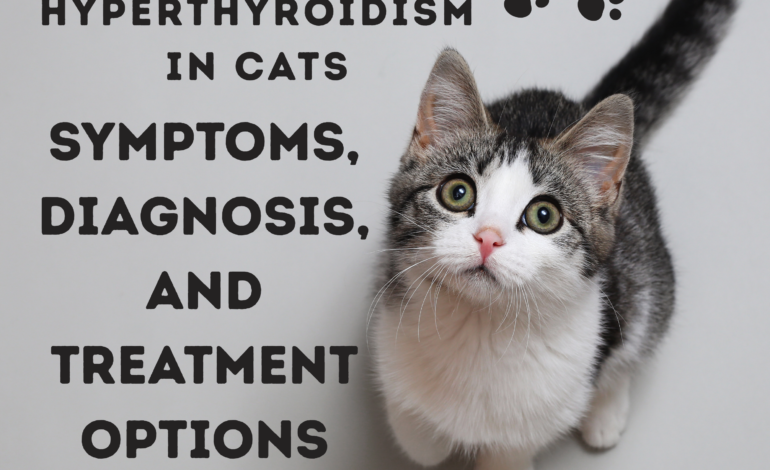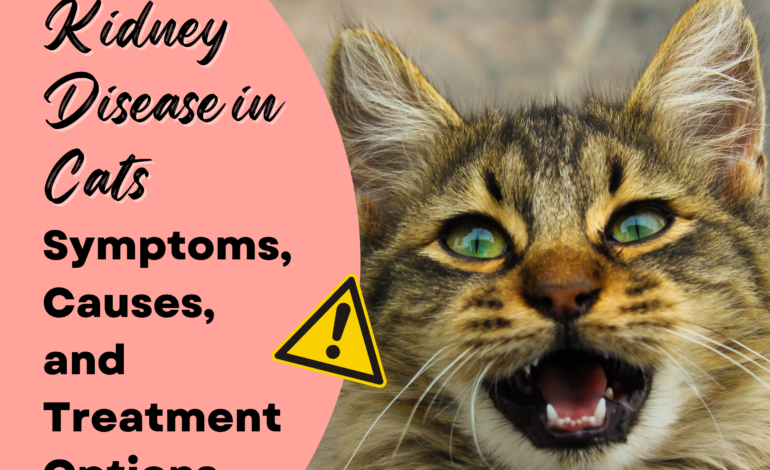Hyperthyroidism in Cats: Symptoms, Diagnosis, and Treatment Options

Did you know that in a study of nearly 28,000 cats in Spain, about 6.2% were diagnosed with hyperthyroidism? Among cats over 10 years old, that number climbed to almost 7.9%. (1)
Hyperthyroidism—sometimes called an “overactive thyroid”—occurs when a cat’s thyroid gland produces too much thyroid hormone. In hyperactive thyroid cats, this causes a metabolic rev-up: elevated heart rate, increased appetite, weight loss, frequent thirst and urination, and sometimes even behavior changes.
It matters because the symptoms sneak up quietly, and by the time owners notice them, the glands may already be quite enlarged. Early detection and treatment—not just reacting once signs appear—can make a huge difference in comfort, longevity, and avoiding complications like heart or kidney damage.
What is Hyperthyroidism in Cats?

Hyperthyroidism is the result of one or both thyroid glands producing too much hormone (T4). These hormones typically control metabolism, energy and organ function. But when we spike, the body goes into “fast-forward.” Cats start running down their energy reserves too fast, which is why they can eat like there’s no tomorrow but still lose weight – and add stress to organs such as the heart and kidneys.
The hormone that the thyroid secretes has its hands in just about everything: appetite and heart rate, digestion and body temperature. Too much upsets the entire system.
Hyperthyroidism is one of the most common endocrine diseases of older cats in the U.S. Average age of diagnosis is approximately 12-13 years and Banfield Pet Hospital data finds the condition in about 1.7% of cats, with higher prevalence along the Pacific Northwest and East Coast. (2) There is no sex predilection.
A lot of cat parents, for instance, will share that their senior cat has suddenly started to act like a “kitten again” — dashing through the house at all hours of the night, meowing in seemingly unrelated frequencies during parts of the day and begging endlessly for food. “Well, that sounds cute, but it’s more likely to signify an overactive thyroid than a playful streak.
One little-noted but important observation: the treatment of hyperthyroidism can occasionally “unmask” kidney disease. Elevated thyroid levels are known to temporarily increase kidney function, potentially masking underlying problems. When treatment brings hormone levels low enough, those kidney problems can crop up again — making regular monitoring necessary.
Hyperactive Thyroid in Cats Symptoms

“Hyperactive thyroid in cats symptoms” might start quietly — something you notice only when you look closely. Here are the signs to watch for, including both early and advanced:
- Weight loss despite increased appetite — one of the most common first clues. Cats suddenly seem always hungry, yet their body condition slips.
- Increased thirst and urination — the body’s metabolism speeds up, kidneys work harder, and cats often drink more and pee more.
- Poor grooming habits — coat looks unkempt, greasy, or matted because the cat doesn’t keep up with grooming (comfort/pain issue perhaps).
- Restlessness, irritability, aggression — some cats pace more, are harder to settle down, may be more grumpy or reactive than before.
- Increased heart rate, rapid breathing, murmurs — heart and lungs often show stress, and vets may hear murmur or detect faster pulse.
- Vomiting, diarrhea, heat intolerance — digestive upset is common, and cats may be more sensitive to warm temperatures (due to higher metabolism).
- Advanced signs: panting, weakness, lethargy — if untreated, symptoms worsen until the cat struggles to keep up with everyday activities, may tire easily, show weakness.(3)
⚠️ Note: Symptoms may be subtle at first and worsen gradually. It’s common for weight loss, increase in hunger, or coat changes to be ignored until more dramatic signs appear.
Causes of Hyperthyroidism in Cats

Most cats with hyperthyroidism have a benign enlargement of the thyroid tissue (a condition known as nodular hyperplasia). This is the cause in about 97–99% of cases in cats. (4)
An even smaller fraction — roughly 1–2% — are caused by thyroid adenocarcinoma, a cancerous tumor that calls for more aggressive treatment like surgery or radioactive iodine therapy.
The disease is similar to toxic nodular goiter in people, a condition where thyroid tissue swells and grows overactive as it ages.
💡 Overlooked insight: Although most conversations stop at “benign growth,” growing evidence suggests that environmental exposures — for example, to flame retardants in household dust or to particular canned food linings — could be contributing to overactivity of the thyroid gland in some cats.
Long-Term Complications of Untreated Hyperthyroidism

When left untreated, an overactive thyroid doesn’t just make cats restless or thin — it quietly strains vital organs.
- Heart disease: Extra thyroid hormone makes the heart pump harder and faster, which can cause thickening of the heart muscle (a condition called hypertrophic cardiomyopathy) and may eventually lead to heart failure.
- High blood pressure (hypertension): This is one of the most dangerous ripple effects. Uncontrolled hypertension can cause sudden blindness, strokes, and long-term damage to organs like the brain and kidneys.
- Kidney complications: High thyroid levels can “mask” chronic kidney disease by making kidneys filter more efficiently. Once treatment lowers thyroid hormones, hidden kidney problems may show up — a key reason vets monitor kidney function closely during and after therapy.
💡 Takeaway: Hyperthyroidism isn’t just a thyroid issue — it’s a whole-body condition. Catching and treating it early greatly reduces the risk of permanent heart, eye, and kidney damage.
How is Hyperthyroidism Diagnosed in Cats?

Because many thyroid symptoms in cats overlap with other conditions, a proper veterinary exam is essential before treatment.
- Hands-on exam: Vets often start by gently feeling the neck for an enlarged thyroid gland.
- Bloodwork: Measuring the thyroid hormone T4 is the gold standard. High levels confirm most cases, though sometimes results are borderline in early or mild disease.
- Full health check: A complete blood count (CBC), chemistry panel, and urinalysis help rule out other issues and check organ function.
- Blood pressure & heart tests: Hypertension, rapid heart rate, or murmurs are common complications, so vets may run an ECG, ultrasound, or chest X-rays.
👉 Important: Mild or early cases can be tricky to spot — especially if your cat also has kidney or heart disease. That’s why vets sometimes repeat tests over time before deciding on the best treatment plan.
Treatment Options for Hyperthyroidism in Cats

If you’re wondering how to treat hyperthyroidism in cats, the good news is there are several effective approaches. The best choice depends on your cat’s age, overall health, and your ability to manage ongoing care.
- Radioactive Iodine Therapy (I-131): Considered the gold standard, this minimally invasive treatment destroys the overactive thyroid tissue while leaving normal tissue intact. It cures over 95% of cases with a single injection.
- Medication (Methimazole or Carbimazole): Daily oral or transdermal meds suppress thyroid hormone production. It’s effective but requires lifelong use and regular bloodwork every 3–6 months to monitor for side effects.
- Surgical Removal (Thyroidectomy): Removing the thyroid gland can be curative, but surgery carries risks such as damaging nearby parathyroid glands, especially in older cats.
- Dietary Management (Low-iodine diet): Prescription diets (like Hill’s y/d) restrict iodine, which the thyroid needs to make hormones. Effective only if followed exclusively (no treats or table food), so it requires committed owners.
Prognosis for Cats with Hyperthyroidism

With early diagnosis and proper treatment, most cats with hyperthyroidism have an excellent prognosis — many go on to live several healthy, happy years after treatment. Even cats in their mid-to-late teens often rebound with better weight, energy, and coat quality once hormone levels are controlled.
Complications like kidney disease and heart disease can affect long-term outcomes. Hyperthyroidism speeds up kidney filtration, so when thyroid levels are corrected, hidden kidney disease may “show up.” Regular bloodwork and checkups are critical to spot this balance early.
💡 Case in point: At a Banfield clinic in Oregon, a 13-year-old cat named Milo was treated with radioactive iodine. Within 3 months, his appetite normalized, his weight stabilized, and his heart murmur quieted. However, follow-up bloodwork revealed early kidney disease — something that had been masked before treatment. With a renal-support diet and close monitoring, Milo continued to thrive for another 4 years.
This illustrates why ongoing care is as important as the first treatment step. With attentive veterinary follow-up, thyroid disease doesn’t have to cut a cat’s life short.
Prevention & Monitoring Tips

While you can’t always prevent hyperthyroidism in cats, you can catch it early — and that makes a huge difference. Here’s how:
- Vet visits matter — Schedule annual check-ups for middle-aged cats, and every 6 months once they’re over 10. Many vets recommend adding a thyroid blood test (T4) as part of senior wellness panels.
- Routine bloodwork — Hyperthyroidism can smolder quietly. A quick blood test often picks up changes long before symptoms become obvious.
- Home monitoring — Keep an eye on appetite, body weight, drinking/urination, and even grooming. Cats that suddenly look “scruffier” or lose muscle despite eating well may be sending an early signal.
- Support the whole cat — Stress makes chronic diseases harder to manage. Quiet spaces, predictable routines, and enrichment (like climbing trees or puzzle feeders) help keep your cat’s system resilient.
💡 Overlooked insight: Many cat parents think weight loss in older cats is “just aging.” In fact, studies show up to 10% of cats over 10 years old develop hyperthyroidism. Monitoring small changes at home and pairing that with proactive vet care can turn a late-stage crisis into an early, manageable catch.
Conclusion
Hyperthyroidism may sound daunting, but with modern treatments, most cats thrive and enjoy many more happy, healthy years. The secret is early detection and steady monitoring — small changes in weight, appetite, or energy can be the first clues.
👉 If you’ve noticed your cat acting differently, don’t chalk it up to “just getting older.” A quick vet visit and simple blood test can make all the difference.
At Meow Care Hub, we’re here to make feline health less overwhelming and more empowering. Bookmark us, share this with a fellow cat parent, and keep learning — because every cat deserves a long life full of purrs, play, and comfort.
FAQs About Hyperthyroidism in Cats
1. What are the signs of hyperthyroidism in cats?
The most common hyperthyroidism cats symptoms include weight loss despite increased appetite, excessive thirst, frequent urination, hyperactivity, restlessness, poor coat condition, and vomiting or diarrhea.
2. What causes hyperactive thyroid in cats?
Most cases are caused by benign enlargement of the thyroid gland (nodular hyperplasia). Rarely, thyroid cancer (adenocarcinoma) can be the underlying cause.
3. How to treat hyperthyroidism in cats?
Treatment options include radioactive iodine therapy (the most effective), oral medications like methimazole, surgical removal of the thyroid gland, or prescription iodine-restricted diets.
4. Can hyperthyroidism in cats be cured?
Yes, certain treatments such as radioactive iodine therapy or surgical thyroidectomy can cure the condition. Medications and diets, however, typically manage rather than cure hyperthyroidism.
5. What happens if feline hyperthyroidism is left untreated?
Untreated cases may lead to severe complications like heart disease, high blood pressure, kidney failure, and even blindness. Early treatment is key to preventing these outcomes.
6. Is hyperthyroidism painful for cats?
Hyperthyroidism is not usually painful, but the symptoms (restlessness, weight loss, excessive hunger, and heart strain) can significantly impact a cat’s quality of life if left untreated.
Resources:





